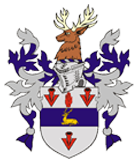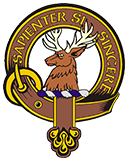Notable Davidsons In USA
If you have suggestions for additions to this list, please contact the Webmaster
BUT, the first entry is an out-of-the-ballpark winner!
This is the story of American Revolutionary War Brigadier General William Lee Davidson. The story was written by the General’s 4th Great Granddaughter, Debbie Sorrels Mecca, esteemed member of the Clan Davidson Society USA. The story is related in two parts, a few paragraphs of explanation by the author explaining who the General was and why she undertook the journey that led to the writing of this story. The second part is a down-loadable PDF-formatted detailed narrative of the life… and death of this true American hero. Let’s get to it!
***
Journey of Discovery to 4th Great Grandfather William Lee Davidson
Personal comments by the author, Debbie Mecca
Greetings to Clan Davidson Society USA (CDS-USA) members and visitors to our website. Every passion has a beginning and I can’t share my ancestor’s story without telling you a bit about myself. As a member of CDS-USA, I have discovered the feeling of “coming home” to family. And now I am privileged to have the opportunity to introduce you to our American Davidson hero, my 4th Great Grandfather, Brigadier General William Lee Davidson.

The author with Gen. W.L. Davidson Reenactor at Rural Hill.
Much of William’s story, as well as his destiny, take place during the American Revolution. In honor of that service, I am a proud member of the Daughters of the American Revolution.
My own interest in my Davidson heritage began with my Grandmother Ira Davidson’s father, Theodore (Thee) Ewing Davidson, who was born in Daviess County, Kentucky in 1844. Thee fought for the Confederacy during the American Civil War along with his friend, Cap Spencer. Much later in life, Spencer took an interest in travelling throughout the country trying to re-locate the men he had fought alongside. That search left my family with three letters, written 49 years after the war.
To make a long story short, those letters left fascinating clues – as do so many small starts on a person’s journey to unravel the secrets of their family’s past. I have gathered many interesting stories about Thee and his adventures in the war, later as a roaming cowboy on the Texas frontier, then finally settling down with his wife Nancy to farm in Texas then Oklahoma where I grew up.
Life is a circle they say. I am now living in Kentucky where Thee started out his life. I have learned so much more about my extraordinary Davidson family – from Grandma Ira Davidson who was born the year her father turned 57 and who shared stories about moving to Indian Territory before Oklahoma was a state, crossing the Red River in a covered wagon on a ferry… then on to her father Theodore Ewing Davidson, to his father George Madison Davidson, to his father Ephraim Brevard Davidson, to his father William Lee Davidson and beyond. I’ve followed my Davidson family back from Oklahoma to Texas to Kentucky to Tennessee to North Carolina to Pennsylvania to Ulster, Ireland and finally, to Scotland.
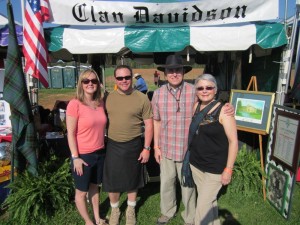
The author and her family at the Clan Davidson Clan Tent
I joined CDS-USA while attending the amazing Scottish Festival and Loch Norman Highland Games at Rural Hill just north of Charlotte, North Carolina. Rural Hill, Center of Scottish Heritage, lies on a portion of what was at one time one of the area’s grandest plantations belonging to William Lee’s “cousin” John Davidson very near the town of Davidson, North Carolina, where Davidson College is located. Both carry the Davidson name in honor of their local Revolutionary War hero as do Davidson Counties in North Carolina and Tennessee. It was also from Rural Hill that William Lee borrowed the horse on which he rode to his final date with destiny and to which the horse returned riderless.
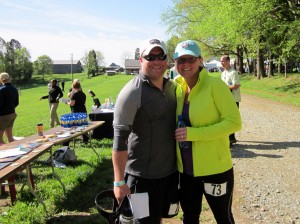
I was told once that this road was likely the one William Lee would have ridden from Rural Hill to meet his destiny after borrowing his Cousin John’s horse.
In this area of North Carolina, I have also uncovered areas in which William Lee settled as a child on Davidson Creek, attended Centre Presbyterian Church, married Mary Elizabeth Brevard, was promoted to Brig. General, then on to Cowan’s Ford where he sacrificed his life in an effort to rally his men in a desperate attempt to halt the advance of Lord Charles Cornwallis and his British soldiers who were attempting to cross the rain-swollen Catawba River February 1, 1781. I have paid my respects at his final resting place in the graveyard of Hopewell Presbyterian Church and later viewed his pistol which is on display at Guilford Courthouse Revolutionary Battlefield Park Museum in Greensboro, N. C.

This plaque is displayed in the vestibule of Centre Church
William Lee was separated from North Carolina very seldom – both times in Pennsylvania: at birth and infancy before heading down that Great Wagon Road, then as an adult while wintering with General George Washington’s Continental Army at Valley Forge.
Descendants of William Lee Davidson settled throughout the United States. Members of the Davidson family are proud and fascinated by this distinguished and well-loved man. In ordinary times William would have lived his life as a farmer/plantation owner and god-fearing man whose story would have been mostly forgotten in time. However, fate had a grander destiny for this Colonial whose chapter is now written in history for all to remember.
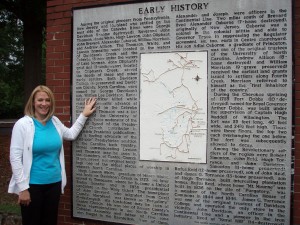
Katherine displays Pinnacle Map
So many facts in this story were discovered along a trail of travel, book reading, and blind luck like the monument to the Pioneers who came early on to Lake Norman pictured to the right. When reading this story, it seems simple that all these facts fell into place. The reader has no idea the thrill of each find…the treasure hunt involved…the location of properties narrowed down…the monuments that lead to clues…the internet which gives such a wealth of information, the distant cousins all over the country who share my love of William’s part in Colonial and American history, and finally–the wonderful articles and books that I’ve listed as resources and from which I’ve drawn much of his life’s story—most especially the war years written about in Chalmers Davidson’s book.
My tale followed William’s life down the Great Wagon Road which at the time was little more than a Warriors Path through the Blue Ridge Mountains, then into father George’s home which operated as an “Ordinary” or Tavern where William Lee would have listened to traveler’s stories and learned to deal with people from all walks of life, serving him so well later as a leader of men during his service to his country and the story that is so uniquely his own.
The following timeline of William Lee Davidson’s life is from the Davidson College Website.
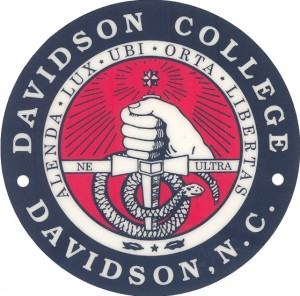
Davidson College Seal
History of General William Lee Davidson
- 1740 William Lee Davidson’s Father, George, moves his family from Northern Ireland to Lancaster, PA
- 1746 Birth of William Lee Davidson
- 1748 The Davidson Family moves to North Carolina and settles in Rowan (now Iredell) County, North Carolina
- 1759 William’s father dies leaving him fatherless at age 13. William begins school at Sugaw Academy, a school operated in connection with Sugaw Creek Presbyterian Church.
- 1767 William and his cousin, George, escort the colonial governor, William Tyron, into Cherokee territory on a boundary-setting mission. This is William’s first official assignment. On December 10th of that same year, William and Mary Brevard, daughter of one of the leading families in the area, announce their engagement. The couple eventually will have seven children together.
- 1770 William’s public career begins with his appointment as constable.
- 1772 After taking the oath of allegiance to King George III as required by law, William is commissioned Captain in the Rowan County militia.
- 1774 Under the burden of heavy taxes and ruthless public officials who represented the king, the citizens of North Carolina hold their first Provincial Congress in New Bern. On September 23rd, the citizens of Rowan County appoint William as one of 25 men to see that the goals and actions of the Provincial Congress are fulfilled.
- 1775 In May, the Mecklenburg Committee of Safety is organized as a government independent of the King. William’s brother-in-law and other family members are among the founders.
- 1776 At the age of 30 years, William is commissioned a major in the Continental Army.
- 1780 On July 21st, William is shot in the stomach as he and his two hundred men try to stop a British detachment. By August 31st, he has completely recovered and is appointed brigadier general in the Continental Army.
- 1781 On February 1st, William is killed in action during the battle at Cowan’s Ford on the Catawba River in North Carolina. His forces were attempting to stop a British army commanded by Cornwallis from crossing the river.
Citation: “History of General William Lee Davidson” as Gillispie, “General William Lee Davidson” Davidson Encyclopedia 2001
Contents obtained from the personal research records of Dr. Chalmers Gaston Davidson ’28, author of Piedmont Partisan: the Life and Times of William Lee Davidson (Davidson, NC: Davidson College, 1968). These records are housed in the Davidson College Archives.
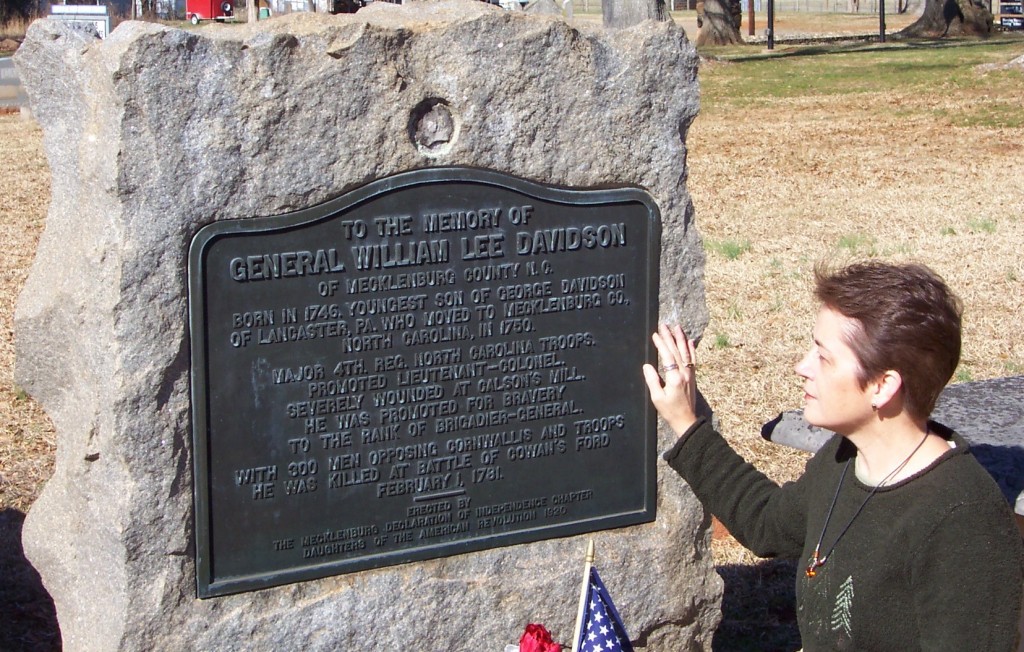
The author at the grave site of her 4th Great Grandfather, William Lee Davidson. Rest In Peace, Grampa…
To download the compleat story of this great American hero, click HERE.
